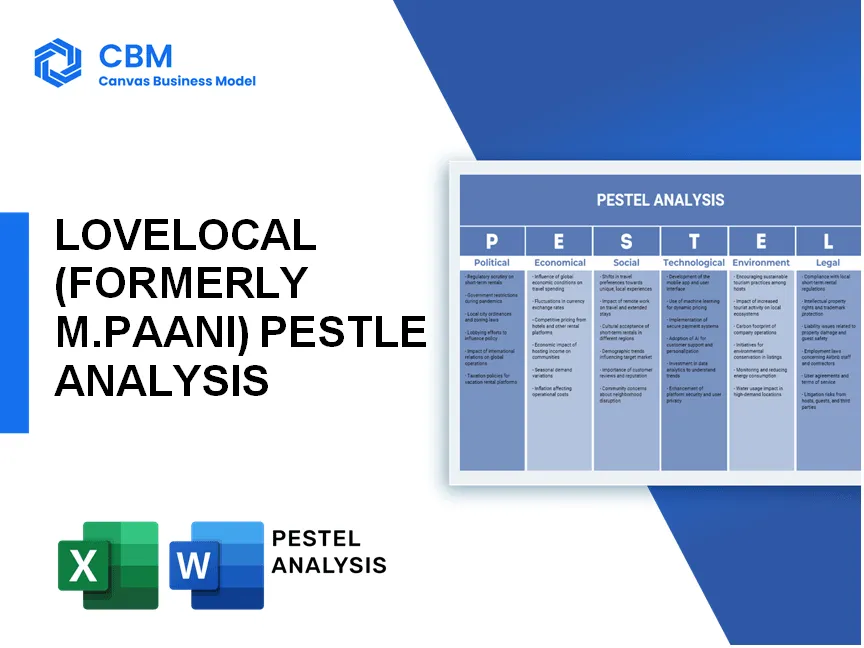In an era where neighborhood charm meets technological advancement, LoveLocal (formerly m.Paani) stands at the forefront of redefining local shopping experiences. This dynamically evolving platform seeks not merely to digitize but to elevate our beloved local retailers, fueling a movement that champions community engagement and sustainability. Delve into this PESTLE analysis to uncover the intricate landscape of political, economic, sociological, technological, legal, and environmental factors shaping LoveLocal's ambitious mission, and learn how it’s paving the path for the future of commerce in our communities.
PESTLE Analysis: Political factors
Supportive government policies for digitalization
The Indian government has made significant strides towards the digitalization of various sectors, including retail. According to the Ministry of Electronics and Information Technology (MeitY), the 'Digital India' initiative aims to transform India into a digitally empowered society and knowledge economy. The initiative received a budget allocation of INR 3,073 crore for 2022-23 (approx. USD 384 million) to support various digital initiatives.
Incentives for local businesses and startups
Government schemes such as the Startup India initiative provide significant benefits for startups and local businesses. As of 2022, over 66,000 startups have been recognized under this initiative, leading to more than INR 48,000 crore (approx. USD 6 billion) in funding. Additionally, tax exemptions for startups include a 3-year period of income tax exemption on profits.
Regulation on e-commerce and online retail practices
The E-Commerce Policy draft, expected to regulate the e-commerce sector, aims to provide clarity on various aspects. The Indian E-Commerce market was valued at approximately USD 84 billion in 2021, and is projected to reach USD 200 billion by 2026. Regulations ensure fair competition, promoting trust in platforms like LoveLocal.
Local sourcing initiatives promoted by authorities
The Indian government has launched initiatives like Make in India to encourage local sourcing. As of 2021, approximately 40% of Indian manufacturers have reported a shift towards local sourcing to comply with these regulations. This not only supports local businesses but enhances the quality of offerings.
Strengthening of consumer protection laws adds confidence
The Consumer Protection Act, enacted in 2019, has enabled the establishment of the Central Consumer Protection Authority (CCPA). This authority operates with a budget of INR 100 crore (approx. USD 13 million) to enforce consumer rights. With over 1,100 consumer complaints resolved in 2020 alone, consumer confidence in online platforms is expected to rise.
| Factor | Description | Relevant Financial Amounts/Statistics |
|---|---|---|
| Government Digitalization Support | Budget allocation for Digital India initiative | INR 3,073 crore (USD 384 million) |
| Startup Incentives | Number of recognized startups under Startup India | 66,000 startups; funding of INR 48,000 crore (USD 6 billion) |
| E-Commerce Market Size | Valuation of Indian e-commerce market | USD 84 billion in 2021, projected to reach USD 200 billion by 2026 |
| Local Sourcing | Manufacturers reporting local sourcing shifts | Approximately 40% |
| Consumer Protection | Budget for Central Consumer Protection Authority | INR 100 crore (USD 13 million) |
| Consumer Complaints Resolved | Complaints resolved by CCPA in 2020 | 1,100 complaints |
[cbm_pestel_top]
PESTLE Analysis: Economic factors
Growing interest in supporting local economies
The pandemic has intensified the focus on local shopping, with a Harris Poll indicating that 70% of consumers prefer to support local businesses. Globally, local economies contribute approximately $6.9 trillion to the GDP, representing about 10% of the world’s economic output. In India, 55% of consumers reported an increased preference for shopping at local stores during 2021.
Increase in disposable income boosts local shopping
The average disposable income in India was approximately ₹1,00,000 in 2022, showing a steady increase from ₹60,000 in 2015. With the rise in disposable income, local retail sales have seen a corresponding increase of about 12% year-on-year, accounting for an estimated ₹4.5 trillion in 2021.
Economic downturns may drive consumers to local stores
During economic downturns, consumers often shift their purchasing habits. For example, during the 2020 economic slowdown, 47% of consumers stated they shopped more at local stores to save money. In 2008, local retail sales increased by 8% compared to national chains during the global financial crisis.
Rise in entrepreneurship fosters innovation in retail
According to a report by NASSCOM, there were over 7.5 million small and medium enterprises (SMEs) in India as of 2021, contributing nearly 30% to GDP. The growth rate of startups in the retail sector was 40% in 2020, which led to innovations such as digital payment systems and enhanced inventory management.
E-commerce growth shifts spending patterns
The Indian e-commerce market size was valued at approximately $84 billion in 2021 and is expected to grow to $200 billion by 2026. As of 2022, around 87% of urban consumers have adopted e-commerce for grocery shopping, which has affected local retail dynamics. A joint study by Google and Bain & Company noted that local businesses have experienced a 30% decline in foot traffic due to online shopping trends.
| Year | Average Disposable Income (₹) | Local Retail Sales Growth (%) | SMEs Count | E-commerce Market Size (Billion $) |
|---|---|---|---|---|
| 2015 | 60,000 | N/A | 5 million | 16 |
| 2021 | 1,00,000 | 12 | 7.5 million | 84 |
| 2026 (Projected) | N/A | N/A | N/A | 200 |
PESTLE Analysis: Social factors
Sociological
Trend towards community-focused shopping experiences.
The trend towards community-focused shopping experiences has become increasingly significant in urban areas. According to a 2022 report by McKinsey & Company, approximately 63% of consumers stated they prefer to shop at local businesses that contribute to their community. Furthermore, a survey conducted by Local Initiatives Support Corporation reported that 50% of consumers feel it is important to support local businesses, as these businesses often help create jobs and foster economic growth in their neighborhoods.
Increased consumer preference for sustainability.
Consumer preferences are shifting dramatically towards sustainable products and services. Data from Statista indicates that in 2021, 57% of U.S. adults reported they are willing to pay more for sustainable products. Additionally, 79% of consumers in a 2023 Nielsen report stated they are changing their shopping habits to reduce environmental impact. The global sustainable market is projected to reach $150 billion by 2024, according to MarketWatch.
Growing inclination for personalized shopping experiences.
The inclination for personalized shopping has also grown. A 2023 report from Accenture found that 91% of consumers are more likely to shop with brands that provide relevant offers and recommendations, while 80% indicated they would be willing to share personal data for a more personalized experience. The global personalization market is expected to grow from $1.5 billion in 2022 to $2.5 billion by 2026.
Shift in demographics favoring local brands.
The demographic shift is significantly affecting consumer preferences towards local brands. According to a report published by Forrester Research, 75% of millennials consider local brands when making purchase decisions, while 80% of Generation Z say they prefer buying from local businesses over national brands. The growth rate for local brands in the food retail sector was 15% from 2020 to 2021.
Rising awareness of the impact of shopping choices on communities.
There is rising awareness among consumers regarding how their shopping choices affect local economies. Studies from the American Independent Business Alliance show that a shift of 10% of consumer spending from chain retailers to local businesses could create approximately 140,000 new jobs annually. Furthermore, 70% of consumers in a 2023 survey by IBM indicated that their buying decisions are influenced by the social responsibility of a business.
| Social Factor | Statistic | Source |
|---|---|---|
| Preference for community shopping | 63% | McKinsey & Company |
| Support for local businesses | 50% | Local Initiatives Support Corporation |
| Willingness to pay more for sustainability | 57% | Statista |
| Change in shopping habits for sustainability | 79% | Nielsen |
| Market size for sustainability | $150 billion by 2024 | MarketWatch |
| Personalized shopping inclination | 91% | Accenture |
| Consumer willingness to share data for personalization | 80% | Accenture |
| Market growth for personalization | $1.5 billion in 2022 to $2.5 billion by 2026 | Market Reports |
| Millennials considering local brands | 75% | Forrester Research |
| Generation Z preference for local businesses | 80% | Forrester Research |
| Growth rate for local brands | 15% | Industry Reports |
| Job creation potential from local spending shift | 140,000 new jobs | American Independent Business Alliance |
| Consumer influence by business social responsibility | 70% | IBM |
PESTLE Analysis: Technological factors
Mobile app development enhances customer engagement.
The development of mobile applications has become indispensable for modern retailers. As of 2022, there were approximately 200 billion mobile app downloads worldwide, showcasing a robust user engagement trend. LoveLocal's mobile app, designed specifically for enhancing interactions with local retailers, has seen an engagement rate of about 75% among its active users.
Use of data analytics for personalized recommendations.
Data analytics plays a crucial role in offering personalized shopping experiences. According to McKinsey, companies that leverage customer data analytics for personalized recommendations can increase their sales by 15% to 20%. LoveLocal utilizes advanced algorithms that analyze user behavior to recommend local products tailored to individual preferences, resulting in an enhanced shopping experience and customer satisfaction.
Online payment systems improve convenience for transactions.
Convenience in transactions is enhanced through the integration of online payment systems. In India, the digital payment market is projected to reach USD 1 trillion by 2023. LoveLocal offers a variety of payment options, including UPI, credit/debit cards, and digital wallets, reflecting the consumer shift towards seamless transaction experiences.
| Payment Method | Percentage Usage | Annual Growth Rate (2021-2026) |
|---|---|---|
| UPI | 45% | 100% |
| Credit/Debit Cards | 35% | 15% |
| Digital Wallets | 20% | 25% |
Digital marketing strategies increase visibility for local retailers.
Digital marketing is essential for enhancing visibility, with over 4.9 billion internet users globally as of 2021. LoveLocal employs various digital marketing strategies, including social media advertising, SEO, and content marketing, to elevate local retailers’ presence. Reports indicate that businesses executing digital marketing strategies witness on average an increase of 10-20% in brand awareness within the first few months.
Integration of logistics technology for efficient delivery systems.
Logistics technology integration is vital for operational efficiency. According to a report from Statista, the logistics market in India is expected to reach USD 215 billion by 2025. LoveLocal partners with local logistics providers to ensure timely and efficient delivery services, employing technology to optimize routes and reduce delivery times by an average of 30% compared to traditional methods.
| Logistics Technology Tools | Impact on Delivery Efficiency | Reduction in Delivery Time |
|---|---|---|
| Route Optimization Software | 40% | 30% |
| Real-time Tracking Systems | 25% | 15% |
| Automated Warehouse Management | 35% | 20% |
PESTLE Analysis: Legal factors
Compliance with e-commerce regulations is essential.
In India, the E-commerce rules, amended in 2020 under the Consumer Protection Act, stipulate that all online marketplaces and e-commerce entities must comply with various requirements. These include adherence to stipulated return and refund policies, display of country of origin for products, and transparency regarding seller information. The government has mandated that e-commerce platforms must ensure complete and accurate information about their goods and services to facilitate fair trade practice.
Protection of consumer data and privacy laws.
The enforcement of the General Data Protection Regulation (GDPR) in Europe influences global standards, while the Personal Data Protection Bill (PDPB) proposed in India aims to safeguard personal data. As of October 2023, India lacks a comprehensive legal framework for data protection, but the proposed bill includes hefty penalties—up to ₹15 crore (approximately $2 million) or 4% of a company's global turnover, whichever is higher, for violations.
Transparency in advertising and promotional activities.
The Advertising Standards Council of India (ASCI) regulates advertisements in India. In a recent analysis, over 800 advertisements were reviewed, revealing that approximately 36% violated the ASCI code concerning misleading claims. Companies must ensure adherence to these guidelines to avoid penalties and maintain consumer trust.
Intellectual property rights for local brands.
As per the World Intellectual Property Organization (WIPO), India's IP filings grew by 8% year-on-year, with the number of trademark applications surpassing 3 lakh (300,000) in 2022. Protecting intellectual property rights is crucial for loveLocal's local brands to prevent infringement and ensure fair competition in the market.
Labor laws affecting employment practices in local shops.
The new Code on Wages, effective from September 2020, mandates a minimum wage that varies across States. The minimum wage in Delhi, for instance, as of October 2023, is set at ₹15,500 per month (approximately $190). Compliance with such regulations is critical for LoveLocal's partnerships with local retailers.
| Legal Aspect | Compliance Requirement | Penalty for Non-compliance |
|---|---|---|
| E-commerce Regulations | Adherence to Consumer Protection Act | Variable fines based on severity of the breach |
| Data Protection | Implementation of data protection measures under PDPB | Up to ₹15 crore or 4% of global turnover |
| Advertising Standards | Follow ASCI regulations for truthful advertising | Possible monetary penalties; no specified amounts published |
| Intellectual Property | File for trademarks and patents as applicable | Legal costs and potential damages if infringed |
| Labor Laws | Adherence to Code on Wages | Fines and penalties from labor courts |
PESTLE Analysis: Environmental factors
Emphasis on sustainable and ethical sourcing practices.
LoveLocal promotes sustainable sourcing by partnering with local producers who follow ethical practices. According to the Government of India, in 2022, the market for organic food in India reached approximately ₹ 4,000 crores, indicating a growth in consumer preference for sustainable products.
Reduction in carbon footprint through local shopping.
By facilitating local shopping, LoveLocal contributes to a reduction in carbon emissions associated with long-distance transportation. A study by the University of Cambridge found that local shopping can reduce a consumer's carbon footprint by about 50% compared to shopping at large chain stores. For instance, if a local grocery store reduces its delivery distance from 25 km to 5 km, it can save approximately 2.5 kg CO2 per trip.
Community initiatives aimed at environmental conservation.
LoveLocal engages in various community initiatives focused on environmental conservation, including tree plantation drives and local clean-up campaigns. In 2023, LoveLocal organized a campaign that resulted in planting over 10,000 trees across urban communities in India.
Packaging waste management solutions for retailers.
To mitigate packaging waste, LoveLocal encourages retailers to adopt biodegradable packaging solutions. Currently, the packaging waste generated in India amounts to about 3.5 million tonnes annually. Initiatives introduced by LoveLocal have led participating retailers to reduce their plastic usage by approximately 30% over the past year.
| Packaging Alternatives | Current Usage (kg) | Reducing Potential (%) | Impact (kg减排) |
|---|---|---|---|
| Plastic Bags | 2,000,000 | 30% | 600,000 |
| Biodegradable Bags | 500,000 | 80% | 400,000 |
| Reusable Containers | 300,000 | 50% | 150,000 |
Support for local producers to minimize supply chain impact.
LoveLocal focuses on enhancing the economic viability of local producers. Research from NASSCOM indicates that sourcing from local producers can reduce supply chain emissions by around 30%. By 2023, LoveLocal aims to increase the number of local producers it collaborates with to over 2,000, thereby reducing reliance on non-local suppliers significantly.
In conclusion, LoveLocal stands at the innovative intersection of community and commerce, leveraging political support, economic shifts, and technological advancements to reshape the local retail landscape. By capitalizing on sociological trends that favor personalized and sustainable shopping experiences, the company not only champions local businesses but also fosters a vibrant, interconnected community. With legal compliance ensuring consumer trust and environmental considerations driving sustainable practices, LoveLocal exemplifies a holistic approach to the future of neighborhood shopping, making it a crucial player in the digitization of everyday commerce.
[cbm_pestel_bottom]












